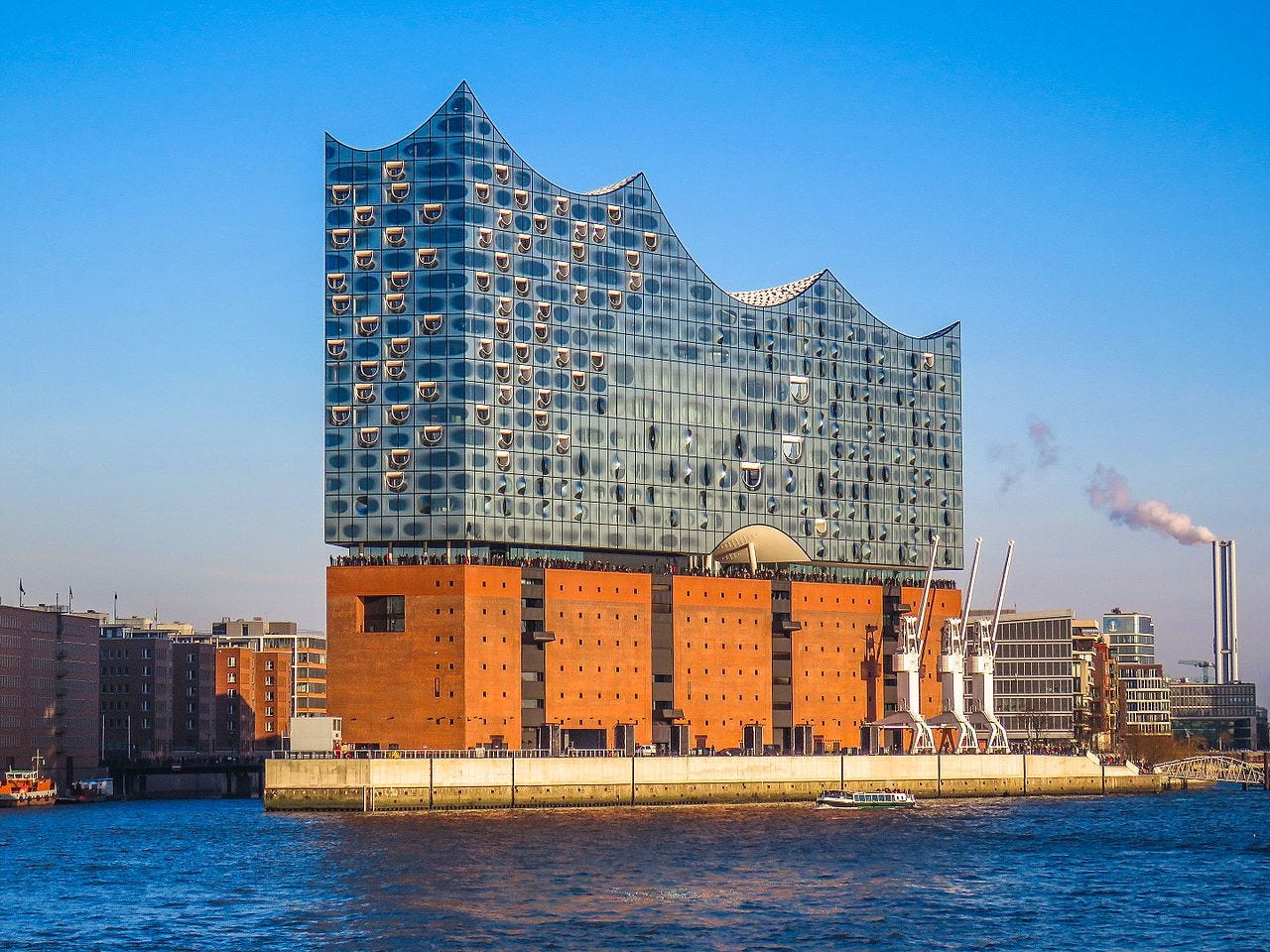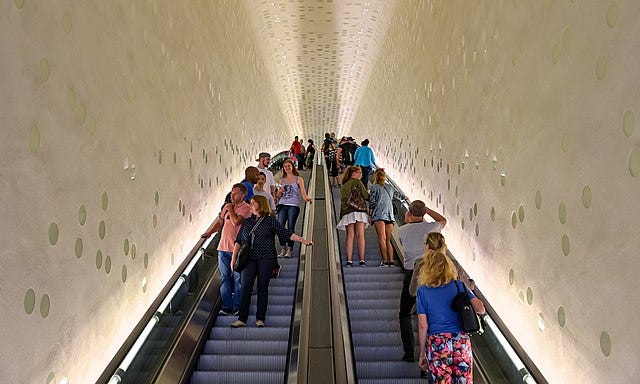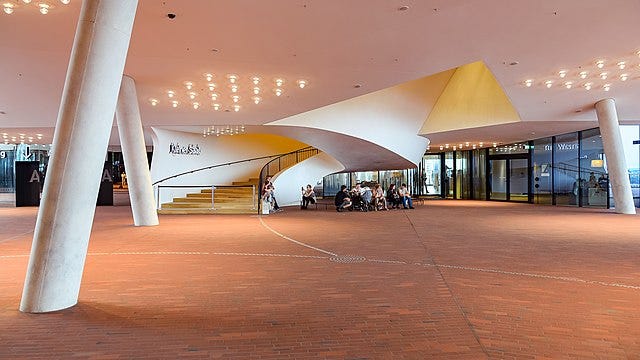Is it possible for a building to have a personality? Furthermore, can buildings have personality flaws? Most people would agree that there are good and bad buildings. Generally, the language of the discourse is going to be in terms of ugliness and beauty: the language of aesthetics. An architectural critic might also point to the function of a building. In such an analysis, they probably have to think about its function over an extended period of time. Most buildings function reasonably well in the first week of their existence. After months, years and decades, the reality of a building’s function comes to light.
The classic case in point is the Villa Savoye, by Le Corbusier, noted architect and less-noted fascist. His villa building is a house, and it quite rapidly failed on basic structural grounds. The biggest problem with the building was with water ingress and damp on the ground floor. I visited the building in the mid 2010s and it felt refrigerated and cave-like.
Such an analysis needs time. This kind of architectural criticism implies a relationship with a building which is deeper and more tangible than a mere image. Indeed, such criticism can’t happen just by looking at Google images or a post card.
Enter the Elbphilharmonie. This building is a postcard of a building, an instagrammable, architectonic pin-up. It’s designed to be photographed. It’s also designed to be experienced. Again, this involves a deeper, more complex relationship with the building. It ceases to be an entirely static object and becomes ‘time based’: the building is a narrative arc, with a beginning, a middle and an end. The beginning of the Elbphilharmonie experience is when one reaches the artificial peninsula in Hamburg on which it sits, proudly. The building, like a sculpture, sits on a plinth. The difference with a true sculpture, though, is that the plinth is gigantic, almost as gigantic as the sweeping chunk of steel and glass which sits on top.

The pedestrian continues their approach, and is greeted by a long rectangular opening, the mouth of the building. Here, there are ticket desks where one receives a free (when I went at least) ticket for the privilege of seeing the building (I was a tourist, not a concert-goer). Next item? Escalators. Really, really long escalators. These escalators sit in angled tunnel like chambers, with plastered walls inset with circles of semi-reflective glass.
Viewers of the Elbphilharmonie, therefore, literally progress through the building at a pace which has been designed by the architects. They must move through it in one direction, and they must move through it with a mechanically determined speed. Architects like to speak of ‘circulation spaces’. These are where people mill about, move from one place to another. Circulation spaces do not invite loitering or lingering. Well, the Elbphilharmonie doesn’t really have ‘circulation spaces’, it has mono-directional people-pumping chambers. Sound inviting? It’s not. It is claustrophobic. The tunnel keeps on going, with its warm light and its entirely unimpressive glass discs.

This tunnel is followed up by a short platform. The purpose of this platform is not entirely clear, apart from providing a) an opportunity for some glazing and the concomitant selfie; and b) a strangely pokey, un-theatrical doorway for a chain hotel which is also housed in the huge structure.
Visitors now make a left turn, about 90 degrees, as they reach for yet another escalator. This time, the escalator is mercifully slightly shorter. We finally arrive in the building’s main internal space. Unlike the cave-like entrance, and the slightly warmer hued cave-like escalator tunnels, this space has a sense of, well, space. The deck feels open up here, and there are semi-indoor spaces which lead to viewing balconies. Another selfie should be taken at one or both of these opportunity sites.
The circulation space itself is painted white, with lots of non-orthogonal walls happening here and there, and some big winding staircases up towards the concert halls. It has an awkward floor plan, where visitors must arc around the staircases and backwards into a café. And, unlike the National Theatre in London (an intensely generous interior) there is nowhere to sit. Apart from one bench.
I want to dedicate a paragraph to this bench. The said article of furniture is built into the structure, permanently affixed to the floor. I’m not sure if the architects looked up their data for the measurements of the bench because the thing sat about 20cm off the floor: so low, in fact, that the seat was significantly less comfortable than a yogic squat. It was also impossibly thin. I’m afraid (again) I don’t have a close-up of this seat, but I do have a handy photograph from Wikimedia Commons which shows people sat on the bench. Look (below) at the knees of the people sat on the bench. They are far higher than their waists. This indicates a very poorly designed seat which will put pressure on the knees and cause pain, quickly. For me, this bench was the big tell of the building: it was where the mask slipped, where its conceit was at its clearest.
Why? Because the bench is fundamentally pointless. It is a waste of space and a waste of materials. It will probably injure someone. All it’s here to do is service the notion of the Gesamkunstwerk, the ‘total work of art’. The bench shoes that the architect has authoritarian control over all features and can design everything including the furniture. The ‘total work of art’ is a bit like ‘total war’: it’s a way of telling you that things are going a bit far. Like any dictator, the Gesamkunstwerk architect makes bad decisions because they are high on the fumes of their egomania.

Returning to what I said above, this building does have a personality and it is a horribly flawed personality. This building is an influencer building: it is a vacuous influencer at that, the kind whose only comment on the universe is the next clothing line that they’re sponsoring. The Elbphilharmonie is worse, though. It’s only got one set of clothing: brick and glass, plaster and white interior paint. It’s a paean to the ‘groovy’ interior spaces of Eero Saarinen et al., but it’s not got any geometric rigour, let alone elegance.
Saarinen’s Trans World Airlines terminal at JFK Airport for example (now a hotel) looks at first glance to be a sort of anamorphic blob, but it’s actually an intensely symmetrical design based on two huge concrete ‘wings’. The Elbphilharmonie is a jokey riff on this kind of thing, but it’s sour and cynical. The TWA terminal is a flawed model anyway because it was designed for an age when flying was, in the words of Sammy Cahn via Frank Sinatra, “rarified.” The terminal couldn’t handle larger numbers of passengers and now it’s a luxury hotel. So much for circulation space.
The Elbphilharmonie doesn’t serve a function—not primarily, at least. The Elbphilharmonie serves itself. It’s ‘me’ architecture, archittention-seeking, egotectonics, a Backstein boast. It’s a menacing presence which is built to photobomb each of the thousands of selfies it elicits. From the photographs, I thought the Elbphilharmonie looked pretty cool. It turned out not to be. Instead, it turned out to be an immersive experience that was a little too immersive. The lesson? Try not to judge a building by its photograph, if you ever can ever avoid it.
Fortunately, one doesn’t have to exit the building in the big escalator tunnels. Visitors take a lift which bypasses all the drama. Then you take another couple of right turns before the final exit door. You’re spat out into the winds of the north sea, grateful for the cold fresh air.




